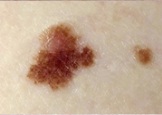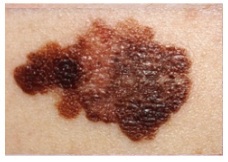Moles Definition
Moles are made of cells called melanocytes. These cells stay clustered in one area creating the darker colored, slightly different area of skin. Normally, these cells are spread evenly throughout the skin to give it pigmentation or color. A mole can be either subdermal (under the skin) or a pigmented growth on the skin.
Lesions, especially ones that have been on the body since childhood, are usually of no concern.
Experts advise to keep on eye on
moles that develop
after the age of 20 or ones that
look different in
appearance from others on your body body
Common Types of Moles
There are different types of moles with varied characteristics. One vital way to fight skin cancer (or any other cancer for that matter) is to know your personal risk and mole types.
Congenital Moles or Congenital Nevi
 These are moles you are born with.
This is a not so common type of mole. Only about 1 in a hundred
people is born with moles. Congenital moles can also develop in childhood. They are generally round shaped, and small in size.
These are moles you are born with.
This is a not so common type of mole. Only about 1 in a hundred
people is born with moles. Congenital moles can also develop in childhood. They are generally round shaped, and small in size.
Although these are often spots where skin cancer first appears if you have an average number of these they aren’t an immediate danger but something to keep an eye on as you age.
Atypical Moles or Dysplastic Nevi
 These are moles that are larger than average size. An average size mole is smaller than a pencil eraser. If you have a mole that is larger than that it is considered to be an atypical mole or dysplastic nevi.
These are moles that are larger than average size. An average size mole is smaller than a pencil eraser. If you have a mole that is larger than that it is considered to be an atypical mole or dysplastic nevi.
Many people who have these types of moles have a large number of them. It also tends to run in families. This increases your risk for skin cancer. These types of moles may be sensitive to sun exposure and this exposure can increase the risk of developing skin cancer.
Blue Nevi
This type of mole is blue in color because the melanocytes are located deep in the skin. The nevus cells are spindle shaped and scattered in deep layers of the dermis. The covering epidermis is normal.
Spitz Nevi
A type of Intradermal nevus, that is most common in children. These are raised and usually flesh-colored (without pigment). A pigmented variant, called the nevus of Reed, typically appears on the leg of young women.
Giant Pigmented Nevi
As the name already points out, these moles are very large and pigmented. Often there is hair growing on them as well.
Further lesions can be classified by MOLE LOCATION into:
- Junctional Nevi: A junctional nevus is usually flat, and black to brown in color.
- Intradermal Nevi: An Intradermal nevus is raised; they are usually flesh-colored (so not pigmented).
- Compound Nevi: This type of mole is a mixture of the junctional and intradermal type. Compound nevi are slightly raised and brown to black. (So they do have pigment). So called "Beauty marks" are usually compound nevi.
Although having more than the common amount of moles (about 30) increases your risk for developing skin cancer it doesn’t mean that you’re doomed.
If you have moles it’s vital to keep an eye on them as time goes on. A good rule of thumb is to do an all over skin exam on your birthday. If you do have higher risk factors for skin cancer then you should also have a regular exam by a health care professional each year to insure early detection if a problem should develop.
Melanomas are a highly curable type of skin cancer.
One of the
most important factors in
curing skin cancer is early detection
It’s vital to get to know your own skin and moles in order to protect yourself and loved ones from skin cancer.




